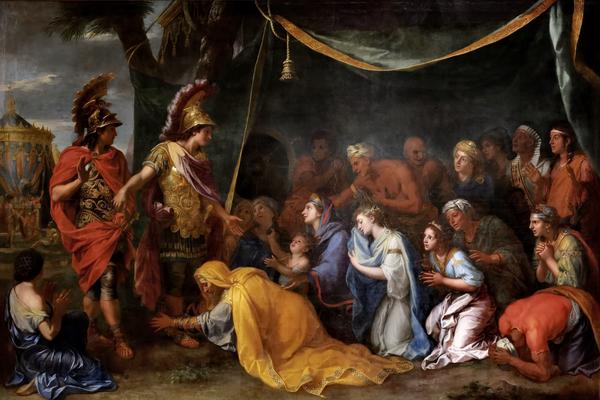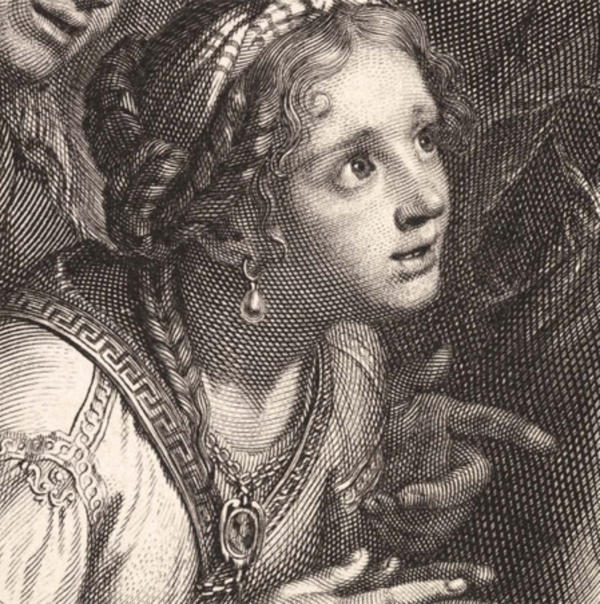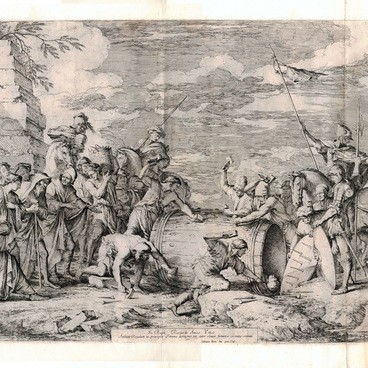Gérard Edelinck created his etching Darius’ Family at the Feet of Alexander the Great on the basis of the painting original by his mentor, Charles Le Brun, a painter and art theorist. The painting was the first one in the series of the History of Alexander the Great commissioned by Louis XIV. The work netted to Le Brun a nobility title, lifetime pension, the position of the King’s First Painter and further commissions.
Darius’ Family
Время создания
1661
Размер
61,3x89,6 cm
Техника
chisel, two boards
Коллекция
6
Открыть в приложении#3
Gérard Edelinck
Darius’ Family at the Feet of Alexander the Great
#2
#5
Darius’ Family at the Feet of Alexander the Great, Charles Le Brun. img via: commons.wikimedia.org
#7
The subject refers to the offensive wars by Alexander the Great with Persia. According to the historian Arrian, after the battle of Issa, the Persian King Darius III was defeated and fled. In the camp abandoned by the Persians, the Macedonians got possession of gold, and also a son, two daughters, the wife and the mother of Darius.
The day after the battle, Alexander the Great, together with his Lieutenant Hephaestion, went to see the captured family of the Persian King. Statira, Darius’ elder daughter, and Sisygambis, his mother, extended royal honors to Hephaestion, having mistaken him for the King: the Greek was taller than slouching Alexander and was dressed in the same way. Sisygambis apologized, and Alexander took her by the hand, helped her to get up and said, pointing at Hephaestion: ‘You are not mistaken, Mother, he is also Alexander’. Taking the historian’s story as a basis, Le Brun painted Sisygambis in the center, at the feet of Alexander, and to the right of her, he depicted a group of women and eunuchs, as well as Darius’s wife with his little son spreading his hands to Alexander.
The day after the battle, Alexander the Great, together with his Lieutenant Hephaestion, went to see the captured family of the Persian King. Statira, Darius’ elder daughter, and Sisygambis, his mother, extended royal honors to Hephaestion, having mistaken him for the King: the Greek was taller than slouching Alexander and was dressed in the same way. Sisygambis apologized, and Alexander took her by the hand, helped her to get up and said, pointing at Hephaestion: ‘You are not mistaken, Mother, he is also Alexander’. Taking the historian’s story as a basis, Le Brun painted Sisygambis in the center, at the feet of Alexander, and to the right of her, he depicted a group of women and eunuchs, as well as Darius’s wife with his little son spreading his hands to Alexander.
#9
fragment of the engraving
The work by Edelinck is meticulous and delicate. This is evident from the selected fragment of the engraving of 5×5cm showing the face of Darius’ daughter: the girl is paralyzed with fear in front of Alexander. The small square accommodates over one thousand lines made on the copper plate with a chisel.
#12
Gérard Edelinck was awarded with the position of a professor, the King’s Engraver; as from 1677, he became an Academician, a Counselor and the First Draftsman of the King’s Cabinet. Louis XIV presented him with a pension and a free apartment at the Gobelin Manufactory. Edelinck lived in Paris till he died.
#11
Gérard Edelinck, of Flemish origin, is one of the first outstanding artist of reproductive engraving of the 17th century. He had been studying art in his native Antwerp under Gaspar Huybrechts and Cornelis Galle until he became 26, and in 1666, he moved over to Paris. Edelinck preferred styles and techniques of the French school: most often, he worked with chisel on copper; he mastered a thin well-ordered linear stroke and, as a rule, used paintings as originals. Nonetheless, Edelinck did not focus on reproducing the paintings in detail. He preferred to reconstruct events based on real or possible events. Reproductive engravings by Edelinck are independent and critical re-evaluation of paintings by others, translation from the language of painting to the language of engraving.
#13
Irbit State Museum of Fine Arts
читать дальшескрыть
00:00
00:00
1x
Darius’ Family
Время создания
1661
Размер
61,3x89,6 cm
Техника
chisel, two boards
Коллекция
6
Открыть в приложении
Поделиться




